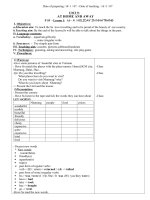Unit 9 - D. Writing - information about Sahara
Bạn đang xem bản rút gọn của tài liệu. Xem và tải ngay bản đầy đủ của tài liệu tại đây (68.13 KB, 2 trang )
Lesson plan 12 - Hµ Thu Hoµ - Chieng Sinh Upper Secondary School
Two thousand camels plod along a dried-up riverbed. The camels are being driven to market. Their
destination is hundreds of miles away, in Egypt. The journey takes many weeks. For as far as the eye
can see, the camels and their herders are the only signs of life. This is the world’s largest desert. This is
the Sahara.
SAHARA MEANS “DESERT”: The name Sahara comes from the Arabic word for “desert.” It is a
vast region that extends across parts of ten countries in northern Africa. The Sahara stretches the entire
width of the continent, from the Atlantic Ocean in the west to the Red Sea in the east. In fact, the
Sahara is almost as large as the United States.
HOT, COLD, AND VERY DRY: In this great desert, daytime temperatures can be scorching. The
highest outdoor temperature ever recorded, 136° Fahrenheit (58° Celsius), was in the Sahara in 1922.
In winter, it can get chilly enough at nighttime for water to freeze.
The Sahara is very dry. Most parts of the desert receive just a few inches of rain a year. Some areas
receive less than 1 inch (2.5 centimeters) a year. In other areas, years pass without any rain at all.
THE LAND
The Western Sahara is a region of rocky plains. The central Sahara has several mountain ranges. Some
of the highest mountains have snow all year. The eastern region is the driest. It is mostly sand dunes.
Some dunes extend for hundreds of miles!
OASES
In the Sahara’s interior, no permanent streams flow across the surface. Dried riverbeds fill with water
only when it rains. But water does rise to the surface in places, mostly from springs and wells. These
areas are called oases.
There are hundreds of oases scattered across the Sahara, mostly along its edges and in mountainous
areas. Oases can support abundant plant and animal life.
Outside the oases, only short, thorny bushes grow. But the bushes support plant-eating animals such as
antelope and gazelles. Jackals, foxes, and hyenas prey on the plant eaters.
WHO LIVES IN THE SAHARA?
Until about 5,000 years ago, the Sahara was wet enough to support fertile grassland. Farmers grew
crops and raised cattle. Ancient rock paintings show the human and animal life of this time. But as the
region dried up, the farmers left.
For thousands of years afterward, the Berber and other desert people have lived and traded in the
Sahara. Their camels have carried gold, salt, and other goods between the oases. Thanks to this trade,
towns such as Timbuktu (now called Tombouctou) grew into rich cities.
Lesson plan 12 - Hµ Thu Hoµ - Chieng Sinh Upper Secondary School
Today, some desert people still trade by camel across the desert. Others have replaced their camels
with trucks. In oases, farmers grow date palms, wheat, barley, and vegetables.
Life in the Desert:
Not many plants and animals can survive the brutal heat and dryness of the Sahara. Thorny shrubs and
hardy grass, shown here, are often the only plants that will grow.









